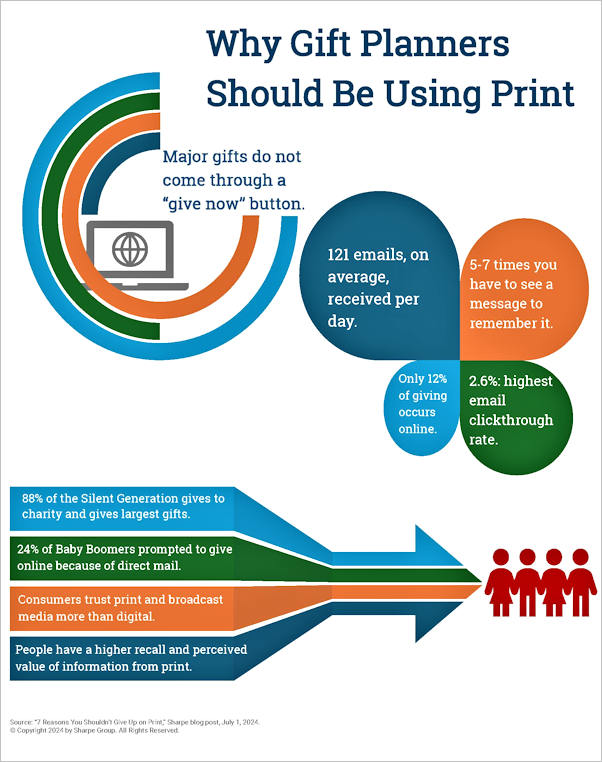In the three decades I’ve spent as a marketing professional, I’ve seen many changes in how we communicate and consume information. Years ago, I worked for a local public broadcasting station during the time analog television was transitioning to digital. As P.R. director, I spent a lot of time on the phone helping viewers install converter boxes and program digital channels.
I found it particularly difficult to walk many older viewers (and public television’s average age, outside of children’s programming, is older than average) through the process over the phone and personally visited some of them to help. I saw firsthand how, though older people may have access to technology, they are often limited in their ability and desire to use it.
In my role as a marketer, I use digital communications (email, social media, etc.) frequently, and I understand the temptation to discontinue printing and mailing communications both due to the expense and the amount of effort involved. However, several factors continue to strongly support the impact of print. Consider:
- Your prime audience for gift planning is older.
Pew Research continues to show growth in the number of Americans age 65 and older with smartphones and social media use. However, the research also shows they are also less likely to use it regularly than any other age.
Eighty-eight percent of the Silent Generation gives to charity, and this generation gives the largest average annual gift of any generation. They prefer to give via direct mail and by phone.
One gift planner recently told me of his reasons for making print a priority: “My take is that my target audience will put it aside if they don’t want to read it immediately. Very hard to do with email since few sort and save emails. Also, some of my prospects don’t even own a computer to send them an email. I have a donor (age 90) who told me, ‘I don’t have the internet, and I use a home phone.’ Therefore, anything of importance, I mail.”
- Online giving is still only a small percentage of overall giving.
The amount of online giving continues to grow, but only 12% of giving occurs online.
- Email is not the homecoming queen it once was.
Inboxes are oversaturated with emails. On average, professionals receive 121 emails per day!
Further, email effectiveness rates show you’re still missing at least half of your audience. It’s promising that nonprofit and mission-oriented emails have higher open and clickthrough rates than average, but it’s still not pushing the needle for action. Fewer than half of all marketing emails are being opened. More importantly, a 2.6% clickthrough rate (emails that are generating action) is the highest rate you can hope for.
- Messages seen in multiple formats resonate.
Twenty-four percent of Baby Boomers who give online say they were prompted because of direct mail they received.
How often have you heard the adage that you must see things [insert your favorite number here] times before you remember them? Research supports this. Some experts say you have to see something five to seven times before it becomes part of your memory.
- Digital communications are less trustworthy … and sometimes dangerous.
Numerous studies agree that consumers trust print and broadcast media far more than information provided digitally. In addition, the impact of hacked data and online scams is taking its toll, sometimes shutting down organizations.
- What’s your relationship status?
Major gifts are rarely completed online and are more likely to occur based on their relationship with the organization.
- Your brain agrees.
Brain studies show that your brain lights up differently when you’re reading something in print. People have a higher recall of information when read from print, and they have a higher perceived value of a product or service when viewing a printed piece.
The proof is in the pudding.
So, is email dead? Hardly. The statistics cited indicate that email should not be the only format you’re using. Any marketing expert worth their salt will tell you that an effective campaign uses all tools available. And since a donor’s relationship with the organization is the most important factor in their decision to give, it makes sense to communicate with them in the ways they want you to.
In the “pros” column for digital messaging is the ability to measure its effectiveness. Study your digital analytics to see who is reading your emails and consider the types of gifts generated by them. This will tell you much more about the impact of your own gift planning efforts than any statistic or “industry standard.”
We want to hear from you!
Share your own experiences and analytics with us! At Sharpe, we care about what helps you raise large gifts, and we all would benefit from hearing about each other’s successes. Send your results and anecdotes to info@sharpegroup.org.
 Teri Sullivan is vice president of marketing for Sharpe Group. You can connect with Teri at teri.sullivan@sharpegroup.org or via LinkedIn.
Teri Sullivan is vice president of marketing for Sharpe Group. You can connect with Teri at teri.sullivan@sharpegroup.org or via LinkedIn.


